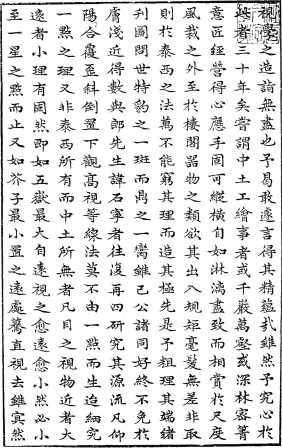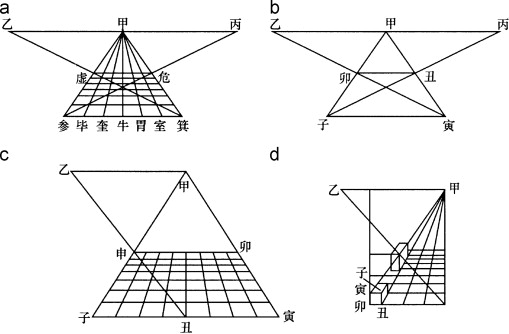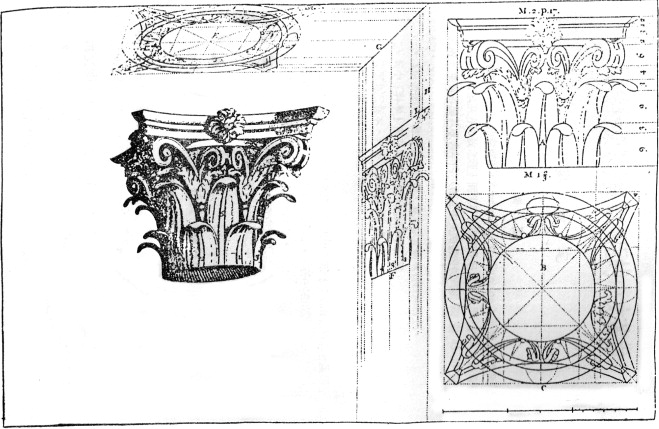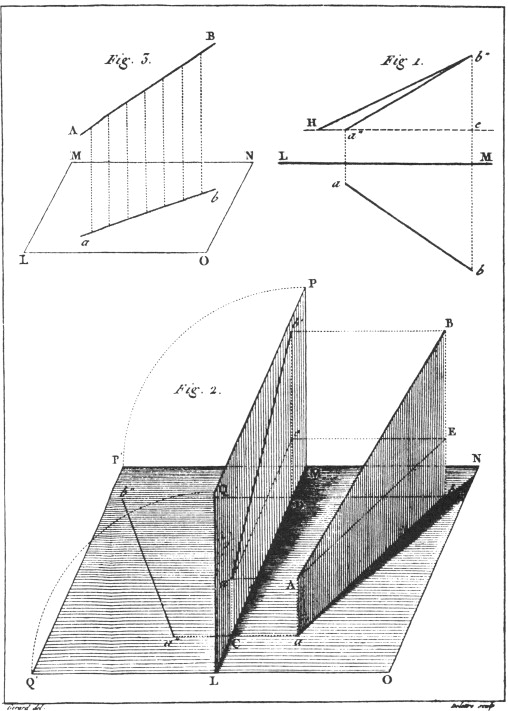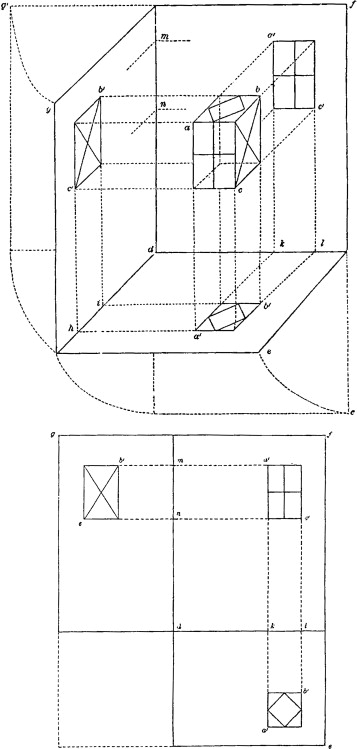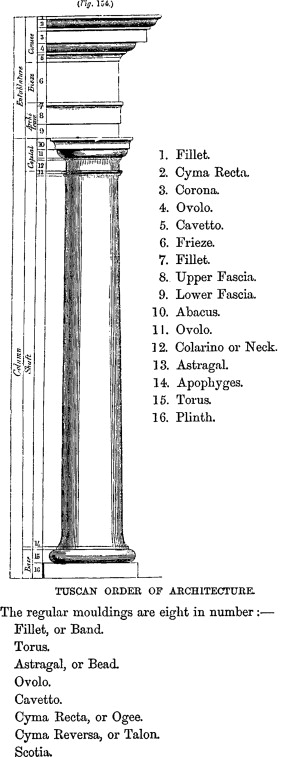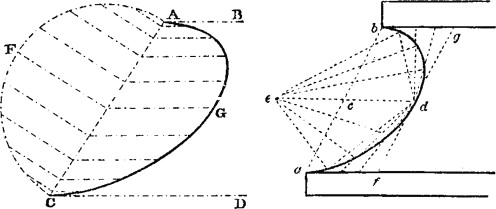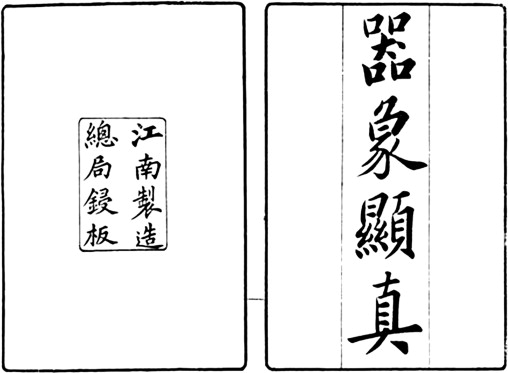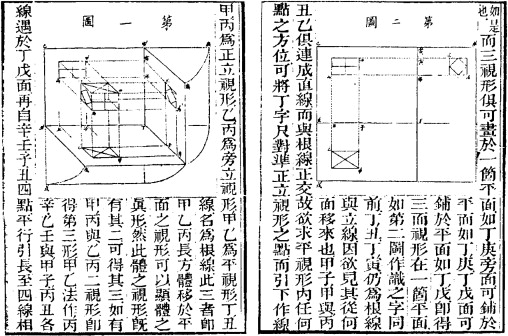Abstract
Western architectural drawing techniques were introduced to China in the 1870s, when their importance was increasingly recognized by the Chinese. The development of architectural drawing in the nation led to the dissemination of knowledge on engineering drawing and enhanced the integration of different theories of drawing from both China and the West. Based on the translation of two western classical texts—Shi Xue (The See ) and Qi Xiang Xian Zhen (The Engineer and Machinist’s Drawing Book )—this study examines the technical development of architectural drawing in modern China.
Keywords
Modern China ; Architectural drawing ; Shi Xue ; Qi Xiang Xian Zhen
1. Introduction
The contributions of China in the historical development of graphics around the world declined during the Ming and Qing dynasties. After this period, the nation completely lost its role in the field and withdrew from the historical stage. Around this time, China experienced a slow development in science and technology, but despite such difficulties the scholars of graphics of the period made some advancement in sorting out and elucidating theories of graphics and techniques of drawing and painting. They also absorbed the theories and techniques of western graphics while studying and disseminating them, thus helping increase the knowledge and innovative achievements in graphics both at home and abroad. The emergence of Shi Xue (Study of Vision) and Qi Xiang Xian Zhen (The Engineer and Machinist׳s Drawing Book) , the two representative works on modern theories of western graphics introduced during the Qing dynasty, exemplifies the achievements in engineering graphics and techniques of architectural drawing in this period. These books concretely reflect the evolution of traditional graphics into modern and contemporary graphics.
2. The introduction of perspective theory of modern graphics and Shi Xue
In ancient times, the Chinese produced work instruments based on their observations of the workings of nature. This process continues to develop until today. Nothing is exempted from the rule “construction in line with the drawings” from ancient times to the present, both at home and abroad. The archive of architectural drawings during the Qing dynasty is called the “Yang Shi Lei Tu Dang,” which refers to the drawing files named after the Lei family who was in charge of the bureau of design for many generations. Graphics flourished during this period and was a booming phenomenon crowned with great achievements. However, its theoretical basis, particularly that of the application of the method of projection, the definition of the proportion of patterns, grid drawing, and iron modeling, remained steeped in the theory of graphics and techniques of contracting inherited from the earlier Qin dynasty to the Sui, Tang, and Song dynasties. Many problems remained unresolved in the field of graphic theories. Valuable works on the method of projection and the innovation of drawing techniques were seldom produced. These issues were left by unresolved by the “Yang Shi Lei Tu Dang.”(Needham et al., 1971 )
Only when the graphics of the Ming and Qing dynasties is considered from the perspective of the history of the field across the world can the development of graphics in the east and west during this period be understood in a holistic way. After the 16th century, when the architectural graphics of China was stagnating along the traditional route, modern science and technology were emerging and booming in the West. Such developments formed a great and influential force in the physical and spiritual life of man. Accordingly, as one of the important parameters of the development of science and technology, graphics increasingly advanced along with emerging theories and approaches. The introduction of a series of basic conceptions, such as the center of projection, picture plane, distance, center of vision, horizon, and far distant point, into the theories of engineering graphics by some western scholars catapulted the field into a new stage of development. The basic principle of the theory of perspective, which was at this time understood primarily by the general public, paved the way for the argumentation of perspective in mathematical terms.
2.1. Development of graphic drawing in the west
The basic conception of the system of focus perspective proposed by the Renaissance artists is the principle of projection and section view. In the 17th century, the French mathematician Girard Desargues (1591–1661) developed this basic principle and introduced projection and section view as a new proof for or method of examining several different types of conic curves, forming a new mathematical discipline called projective geometry.
The Italian scholar of graphics Andrea Pozzo (1642–1709) published Perspectiva Pictorum et Architectorum between 1693 and 1698, which argued for perspective drawings, that is, drawings whose perspective was based on the two orthogonal projections of an object. He also introduced the drawing of buildings expressed by two orthogonal projections.
The British mathematician Brook Taylor (1685–1731) and the German geometrician Johann Heinrich Lambert (1728–1777) both made breakthroughs in the development of perspective drawing. Taylor examined the resolution of basic location issues and the approach to defining various properties of the original object according to perspective drawings. Lambert diagrammatized a few important issues of elementary geometry based on perspective principles and drew perspective with the center of projection at infinity according to the property of affinity correspondence (Booker, 1963 ).
2.2. Nian Xiyao and Shi Xue , the first treatise of graphics in China
During the late Ming and early Qing dynasties, various preachers came to China and introduced the western perspective. The painters among these preachers applied focus perspective in drawing by furthering the landscape and strong stereo feelings, which attracted the attention of the scholars of graphics of the Qing dynasty. Nian Xiyao (?–1738), whose official position was as high as that of the assistant minister of the Ministry of Works during Yongzheng׳s reign, met several times with Giuseppe Castiglione (1688–1766), an Italian Jesuit, also known in China as Lang Shining.1 Nian later compiled and published his book Shi Xue , publicly introducing the principle and approach of perspective drawing. While Lang Shining greatly contributed to the dissemination of the principle of the western perspective, Nian’s Shi Xue marks the crowning achievement of Chinese scholars of graphics who attempted to capture and integrate western scientific ideas.
As the earliest treatise that systematically elaborated the theory of graphics during the Qing dynasty, Si Xue was also a milestone in many other respects. It was the first written work to discuss descriptive geometry and to elucidate the application of the “method of points of distance” in drawing parallel and angular perspectives. It was the first to discuss the application of two side views of a geometrical solid and the intercept of sight lines in the coordinate axes of drawing perspectives. It was also the first to elaborate the drawing method of the shadows of the light source at the center of an axonometric drawing. The book was an excellent work and the first of its kind in the history of graphics in China, with elaborate illustrations and substantial length. Unfortunately, it had only a limited print run and only a few copies of the book remain available (Figure 1 ).
|
|
|
Figure 1. Photocopy of Shi Xue by Nian Xiyao. Source : Nian Xiyao. Shi Xue . 1735. Introduction (Bian Yan), p. 4. |
In his introduction to the book (“Bian Yan”), Nian acknowledges the great help of Lang: “I was introduced to the method of drawing lines from the fixed points at the beginning, which can describe every variation of objects. Once the location is set, other parts continued to have positions. Although their difference is extremely tiny, they cannot be interchanged.” Nian accompanied his discussions with vivid descriptions of the drawing techniques of the focus perspective. He also says that he learned the theory of perspective from Lang. When one applies the theory of perspective in drawing, one can “describe every variation of objects.” Based on the existing techniques of drawings at the time, Nian further adopted “western academic achievements” and applied “western techniques to Chinese drawings.”
The illustrations in this book were not enough; consequently, Nian considered revising this original version and “for many times made drawings,” providing numerous illustrations. He decided to revise Shi Xue and cut blocks for printing and publication. The book was the scientific outcome of his 30-year-long research in graphics.
In his introduction, Nian also addresses Castiglione with respect and calls him “Scholar Lang,” suggesting that the two treated each other as equals. This mutual exchange is the reason why Shi Xue presents a hybrid form of knowledge informed by both western and Chinese cultures. Nian attempted his best and valued the role of Castiglione in completing the book. However, Nian also casts doubt on the effect of applying western drawing techniques: “although western painting can be said to be neat, it is still craftsmanship and cannot be included into the category of excellence… however, it is not appreciated as elegant, and people who are fond of antiquity are attracted to it.” Based on these opinions, Nian continued to explore how to complement the shortcomings of Chinese techniques with the advantages of western techniques.
After the publication of Shi Xue in 1729, Nian furthered his exploration and often discussed with Castiglione, thereby deepening and advancing his understanding of the theory of western perspective. He was dissatisfied with the original version of Shi Xue , so he had it republished in 1735 with substantial modifications and revisions.
In his foreword to the revised version, Nian summarizes his new discoveries in the years after it was first published. He states that “as for buildings and pavilions as well as instruments and appliances, if every rule is to be obeyed and everything is drawn exactly the same, one shall take the advantage of the Western approaches, or the principles cannot be explored and the extreme excellence cannot be reached.” This passage shows that Nian recognized that the principle of perspective is necessary to achieve accurate targets; they can only be “appreciated beyond scales and styles.” If accuracy is required and the drawing is used as the foundation of the construction, then one acknowledges the western approach.
Although Nian recognized the achievements of the Chinese approach to painting, he also continued to draw on the accuracy of the western approach to painting. He attempted to combine both approaches to form his theory of graphic drawing. Being a monograph on graphics with relevant theories and approaches, the 1735 version of the Shi Xue represents the consolidation of Nian׳s research, enriched both by western theories of perspective and drawing techniques and Chinese theories and methods. From this perspective, the 1735 version of the Shi Xue may be seen as a mature treatise on descriptive geometry. With its “varied types of objects, the movements of points, lines, and planes, and the further exploration of the origin of this method, it can be seen as an effective way to access the study of vision.” ( Yang, 1993 )
All volumes of the revised Shi Xue were elaborately printed in woodcut. The book has 132 pages, undivided into volumes or chapters. The first five pages contain the author’s foreword to the original and revised versions. Page 6 contains an illustration of the instruments of drawing perspective, such as the compass and T-square. Pages 7–95 contain illustrations and descriptions of perspective and pages 96–132 contain illustrations and descriptions of projection. A total of 125 pages contain illustrations, 75 of which are accompanied with textual descriptions. The book raises 60 issues. The descriptive texts of the illustrations consist of 10,000 characters. The illustrations are finely drawn, the layout of the pages is reasonably arranged, and the textual parts make up a detailed elaboration of the theory and method of drawing which is discussed in ShiXue is shown in Figure 2 .
|
|
|
Figure 2. Principle of perspective drawings illustrated in Shi Xue . Source : Nian Xiyao. Shi Xue . 1735. Plates V, VI, VII and VIII. |
To a modern reader, the style and layout of Shi Xue will look similar to present-day monographs on graphics. For example, relevant illustrations are used to introduce corresponding theories and the concrete process of drawing. Therefore, it deserves to be called the first systematic monograph that contains drawing theories and methods in China.
2.3. Theories of graphics presented in Shi Xue
The theories of graphics discussed in Shi Xue cover almost every aspect of graphics. The principles of perspective include the methods of points of distance, double points of distance, intercepts, and upward viewing. These theories cover almost all the fields of engineering graphics in the West.
Some of the basic concepts of perspective and the terminology of geometry employed by Nian differ from those commonly used in modern times, but remain coherent in meaning. A comparison of Nian’s and modern-day terminology is shown in Table 1 .
| Terms in Shi Xue | Terms commonly used today | Terms in English |
|---|---|---|
| Luan Dian (chaos point) | Mie Dian (literally means vanishing point) | Vanishing point |
| Li Dian (distant point) | Liang Dian (measuring point) | Point of distance |
| Tou Dian (head point) | Zhu Dian (main point) | Center of vision |
| Di Ping Xian (horizon) | Ji Xian (basic line, also called Di Ping Xian ) | Ground line |
| Mu (eyes) | Shi Dian (eyesight point) | Point of sight |
| Shi Ping Xian (horizon of eyesight) | Shi Ping Xian | Horizontal line |
It was 1730s when Shi Xue was published at Yong Zheng ruling period. At the time of the Shi Xue ’s publication, the theoretical system of western perspective has not yet come of age. Shi Xue was unique among the treatises on graphics in China in terms of its profound theorization, concise calculation, precise supposition, elaborate illustrations, and pioneering integration of western and eastern ideas. In terms of its achievements, this book can compete with those on western graphics at the time. The principle of projection discussed in Shi Xue is shown in Figure 3 .
|
|
|
Figure 3. Principle of projection discussed in Shi Xue . Source : Nian Xiyao. Shi Xue . 1735. Plates XXIX, XXX. |
Nian’s ideas on the engineering graphics can be traced to earlier historical stages. The publication of the two versions of Shi Xue can be recognized as the continuation and development of the theory of Chinese graphics. In Nian’s words, “since ancient times, there have been scholars that discussed the issues on painting.” Even as early as the Zhou and Qin dynasties, scholars of graphics had already conducted detailed practices and research on engineering drawings and theories of perspective, leaving numerous theories and discussions.
Zong Bing of the Kingdom of Song of the Southern Dynasties (375–449) made some inferences on perspective drawing. In his Preface of Painting Landscape , Zong says, “now let us unfold a piece of silk on which to allow the distant landscape to project. So the shape of Lang Feng Dian, which means the place where gods live on the top of Kunlun Mountain, can be included in the small piece of silk. To paint three feet vertically is equivalent to as high as thousands of feet. To spread ink over several feet horizontally is equivalent to as far as hundreds of feet.” If analyzed vis-à-vis the present principle of projection, Zong’s theory can be regarded as approximately the “third angle method.”
In the 17th volume of his book Meng Xi Bi Tan , Shen Kuo of the Song Dynasty (1031–1095) points out the characteristics of perspective in traditional Chinese paintings. He states that “concerning the method of painting landscape, the rule ‘small by near and big in the distance’ shall be obeyed, which is similar to one’s viewing rockwork. If the method is the same as observing a real hill, one can only see one layer of mountain when viewing upward from below. How can one see layers of mountains? One cannot see what happens in the creeks and valleys. We can take a house as another example. In this way, one cannot see what happens in the courtyard or in the back lane. If one stands at the east of the hill, the west side of the hill will be the distant view; if one stand at the west of the hill, the east side of the hill will be the distant view. If this is true, how can one paint landscape?” He argues that painters should not be subjected to the narrow views of the “west side of the hill” or “east side of the hill.” Rather, they should “see layers of mountains” and then, by means of recreation, obtain a new picture plane “similar to one’s viewing rockwork” that cannot be achieved in reality. Shen Kuo’s theory of “small by near and big in the distance” is the method of aerial view in the theory of perspective in China. He criticized Li Cheng’s (919–967) “paintings of pavilions and towers on hills. He painted all wide eaves with face upward.” He argued for the method of “small by near and big in the distance,” in which one can apply the technique of “folding high” or “folding distant” with clever reasons. How is this technique akin to lifting open the corners of houses? Such statements are the qualitative description of Chinese perspective drawing in ancient times.
Guo Xi of the Song Dynasty focuses on projection and perspective. In his work Lin Quan Gao Zhi Ji , he discusses the doctrine of the “three remoteness” of perspective in ancient times. He states that “there are three ‘remoteness’ for mountains: looking at the top of a mountain from the foot is called high remoteness; peeping at the back of the mountain from the front is called further remoteness; viewing the distant mountains from the adjacent mountain is called horizontal remoteness.” Recast in the terms of present-day theory, high remoteness translates to upward view, further remoteness to aerial view, and horizontal remoteness to orthogonal projection. In addition, the cavalier perspective with its focus moving horizontally is also included. These theories of perspective in ancient China were widely applied in the practice of painting during the Dunhuang dynasty and after the Song dynasty.
The important reason why Chinese scholars of the Qing dynasty, as represented by Nian, readily drew on the theories of western perspective is that they integrated the theory and practice of perspective from the past dynasties, learning from the West the knowledge of descriptive geometry. Nian was not only dedicated to the study of graphics theory but also pursued an official career for a long time. Access to the court gave him the opportunity to meet Lang Shining and to read Pozzo’s treatise. As his communication with Lang Shining increasingly deepened, Nian was able to make innovations in theory and eliminate old styles of drawing. Learning the drawing theory of perspective from the West is essentially the favorable factor in the writing of Shi Xue . In this book, many illustrations from Pozzo’s treatise were adopted, such as the patterns relating to buildings. Among these pictures, that for the Corinthian order is depicted in meticulous detail, as though it were a delicate flower-basket with well-stacked volutes on the capital, thriving and creeping petals of lonicera japonica. The depiction of this illustration also reflected Nian’s skills in painting. The architectural drawing in Shi Xue is shown in Figure 4 (Shen, 1988 ).
|
|
|
Figure 4. Architectural drawing in Shi Xue . Source : Nian Xiyao. Shi Xue . 1735. Plates XXV. |
3. Qi Xiang Xian Zhen and the introduction of orthographic projection theory in graphics in China in modern times
Given the continuous improvement of basic theories of graphics in modern times, the discipline of perspective underwent a considerable development in the 18th and 19th centuries, 70 years after the publication of Shi Xue . During this period, British and German geometricians examined the resolution of basic location issues and the approach to defining various properties of an object according to perspective drawings. They also diagrammatized a few important issues of elementary geometry according to perspective principles. Works on perspective discussed the representation of the original object with the drawing produced via central projection and expounded through analytical method the theory of the right projecting of solid axes onto a plane and that of isometric projection.
3.1. New development of graphics: Gaspard Monge and descriptive geometry
The renowned French geometrician Gaspard Monge (1746–1818) had a prominent role in developing construction geometry into a branch of science during the French Revolution. The lecture notes that he prepared in the École Normale Supérieure de Paris in 1795 undoubtedly make up an important literature in the history of education in the world in general and graphics in particular. Monge systematized and summarized the gradually accumulated theories and practices of depicting the image of a solid object on a plane. By doing so, he was able to reduce a variety of practical problems into a limited number of purely geometric questions, the solutions to which he found by means of orthographic projection on two mutually perpendicular planes. He also argued that a plane figure that consists of two projections could be seen as resulting from the two projections of the figure in question, rotating around the intersection of two projection planes and ending up being superposed on one plane. The aforementioned intersection of the two planes was later referred to as the "axis of projection."
A review of its emergence and development shows that construction geometry evolved for an extended period of time as other scientific disciplines had. In the first place, it was closely linked to the development of society, given that social demands were what led to the emergence of early drawing techniques. Later, industrial demands spurred Monge in his theoretical exploration and founding of construction geometry. Developments in science and technology, particularly in astronomy, geography, and architecture, could not have been possible without the advancement in graphics. At the same time, these branches of knowledge also contributed to the growth of the then fledgling field of construction geometry, which advanced together with the aforementioned three disciplines. Scientific development in allied areas provided a theoretical basis for the improvement of graphics. Construction geometry emerged and developed with the help of the achievements in analytical and projective geometries.
In constructing the theoretical system of construction geometry, Monge supposed that, in the projection of points and a system consisting of two projection planes, "a point perpendicular to a plane is referred to as its projection on the plane." This assumption shows that construction geometry adopts the method of orthographic projection. In his Géométrie Descriptive , Monge also points out that the system of projection plane has already found wide applications in science and technology, which he cannot claim credit for.
In the section "Theory of Shadow and Perspective" of his book, Monge notes that anyone who acquaints himself with the approaches of the discipline knows that only one projection will not suffice to determine the shape of an object; therefore, two projections should be used because on a single plane one dimension is missing. However, with two projections, the sizes of three dimensions can be determined well. Monge successfully elaborates the advantages of construction geometry in adopting a simple but well-focused approach, an idea that is his unique contribution to graphics. A diagram of Monge׳s construction geometry is shown in Figure 5 .
|
|
|
Figure 5. Diagram of projection in Monge’s Géométrie Descriptive . Source : Gaspard Monge. Géométrie Descriptive. Paris: 1811, p. 13. |
Published in 1798, Géométrie Descriptive was the first book in the history of engineering graphics to systematically describe the general approach to drawing the image of an object on a plane, thereby laying the mathematical foundation for engineering graphics. Monge׳s methodology did not conflict with analytic geometry; instead, it naturally supplemented practical engineering requirements. In his works on construction geometry, Monge raised for the first time the possibility of applying the theory of geometric transformation and established the theory of indexed projection and the study of curves and curved surfaces, to name but a few.
Géométrie Descriptive emerged as a response to the urgent demand for the exploration of theories of cartography from different walks of life. As the theoretical foundation of engineering drawing, the book soon assumed a canonical status in European schools of polytechnics and became a major course in their teaching programs. The institutionalization of the book’s ideas greatly promoted and swiftly disseminated the socialization of engineering drawing and its applications. The numerous textbooks on construction geometry published at the time were characterized by comprehensive discussions and balanced systematization ( Monge and Monge, 18111984 ; Booker, 1963 ).
3.2. Self-strengthening movement since the 1860s and dissemination of graphics in China in modern times
In 1855, the British publisher Blackie and Son published among a series of books The Engineer and Machinist’s Drawing Book in both London and New York. The literal Chinese translation of the title is Gong Cheng Shi Yu Ji Xie Shi Zhi Tu Shou Ce . It is a 117-page folio edition, whose essential contents were compiled from the works by Le Blanc and Armengaud and whose drawings were produced by Numerous Engravings on Wood and Steel. As a handbook, this monograph of graphics covers the contents of drawings applied by engineers in the field of building construction and is partly devoted to the drawing methods of architectural drawings with a total of 16 illustrations. The principle of projection elaborated in The Engineer and Machinist’s Drawing Book is shown in Figure 6 ; Figure 7 (Blanc and Armengaud, 1855 ), while the architectural drawings and drawing processes are shown in Figure 8 ; Figure 9 .
|
|
|
Figure 6. Principle of projection in The Engineer and Machinist׳s Drawing Book. Source : M.Le Blanc, MM.Armengaud. The Engineer and Machinist’s Drawing-Book. Glasgow, Edinburgh, London and New York: Blackie and Son, 1855, p. 107. |
|
|
|
Figure 7. Principle of three-view diagram in The Engineer and Machinist׳s Drawing Book . Source : M.Le Blanc, MM.Armengaud. The Engineer and Machinist’s Drawing-Book. Glasgow, Edinburgh, London and New York: Blackie and Son, 1855, p. 36. |
|
|
|
Figure 8. Architectural drawing in The Engineer and Machinist’s Drawing Book. Source : M.Le Blanc, MM.Armengaud. The Engineer and Machinist’s Drawing-Book. Glasgow, Edinburgh, London and New York: Blackie and Son, 1855, p. 34. |
|
|
|
Figure 9. Drawing process of an architectural drawing in The Engineer and Machinist’s Drawing Book . Source : M.Le Blanc, MM.Armengaud. The Engineer and Machinist’s Drawing-Book. Glasgow, Edinburgh, London and New York: Blackie and Son, 1855, p. 34. |
In a comprehensive survey of the history of the development of both Chinese and western engineering graphics, we see that engineering graphics underwent a rapid development from the 18th to the 19th centuries. This progress is attributable to the advances made in modern western science and technology in general and engineering graphics in particular, including the advancement of research on basic theories and improvements in mathematical methods. This progress of engineering graphics in the West was in stark contrast to that in China, which lagged far behind. In the increasingly difficult political situation and the encroachment of western powers in China, the scholars of the Xianfeng and T׳ung Chih ruling periods during the Qing dynasty adopted an objective attitude in examining the differences and similarities between Chinese and western engineering graphics. All members of society, from high to low, endeavored to learn the advanced ideas of the West to compensate for what the Chinese discipline lacked. They also studied such ideas to further delve into the western approach of “observing Nature and producing instruments for working” and to catch up with the latest developments in engineering graphics in the world. Such pursuits proved beneficial to the development of engineering graphics in modern China.
In Records and Maps of the World , the uniquely far-sighted scholar Wei Yuan (1794–1857) boldly argued for the absorption of the “merits from those foreign invaders for the purpose of outperforming them” and suggested that dockyards and a bureau of firearms be established. Confronted with "a changed situation never experienced in thousands of years" and "mortal enemies never encountered in thousands of years," Chinese men of insight were obliged to reckon with the chances of China׳s success and survival and launched a westernizing project to strengthen the nation and strive for survival.
This Westernization Movement focused on the establishment of modern industries and China spent great efforts in introducing advanced western science and technology, which helped lay the foundation for the dissemination of modern engineering graphics in China. A new idea for the self-strengthening movement that gained ground during Tongzhi׳s reign (1862–1874) was that the precondition to a nation׳s self-strengthening was the machinery of manufacturing. This focus on manufacturing in turn presupposed the need to learn western mathematics and “the approach of observing Nature and producing instruments for working," that is, engineering graphics. Later, this idea was transformed into a most innovative policy in the history of the Qing dynasty.
The Ministry of Foreign Affairs, a new institution created to handle foreign affairs and to spearhead the westernization of enterprises, even equated the discipline of mathematics, the principle of the natural sciences, and “the approach of observing Nature and producing instruments for working" with the Self-strengthening Movement. Learning western engineering graphics as a national policy was a rare practice that had had no precedent in Chinese history. As a famous quip goes, "Disciplines such as mathematics, natural sciences, ‘the approach of observing Nature and producing instruments for working,’ and the method of examining the maps of rivers, once well understood and commanded for use by the Chinese, will guarantee a powerful and prosperous China."
Zeng Guofan (1811–1872), a pivotal figure of the Self-Strengthening Movement, was the first to propose the establishment and development of modern China׳s shipping industry. He remarked that "the wisdom of westerners should be well acquired to manufacture China׳s own cannons and warships." In the late autumn and early winter of 1861, when he began in earnest to look for "men of ideas and great skill," he made preparations for the launching of China׳s ship-building. In April 1862, Xu Shou (1818–1884), together with his son Xu Jianyin (1845–1901) and Hua Hengfang (1833–1902) took on the endeavor of "self-making ships" in accordance with the Anking Ordinance. Xu Shou succeeded in accomplishing a marine steam engine prototype in July 1862 and launched its maiden voyage in January 1864. After this success, Zeng Guofan decided to "enlarge in scale and manufacture more ships."
Xu Shou and his son were well aware of the importance of drawings in the manufacturing process. In An Account of the Department for the Translation of Foreign Books at the Kiangnan Arsenal , John Fryer (1838–1928), whose Chinese name was Fu Lanya, recorded how Xu Shou and his son designed drawings for the "Huanghu" ship." This time, however, the governor assigned Xu a different mission: the building of a ship to see whether it worked well or not. Xu and his son then made a miniature ship based on the sketches in the book of Bo Wu Xin Bian (New Edition of Natural Science ). Using this approach, they prepared themselves for ship-building on a big scale. The implements and materials they used were all derived from native resources. The elder Xu once saw a small ship in Anking and kept a mental image of the ship. He immediately set out to make the drawings on his own and launched the manufacturing of a ship similar to that in his memory. Although Xu and his son experienced extremely difficult situations without assistance from westerners, they took pleasure in working on their own and labored tirelessly. The governor often gave them encouragement as well. The sayings "based on the sketches in the book of Bo Wu Xin Bian " and "to make the drawings on his own and launched its manufacturing" clearly suggest the important role that drawings had in the manufacturing process of the "Huanghu" ship.
The translation of western books gained ground during the Westernization Movement. In February 1863, Li Hongzhang (1823–1901), the successor of Zeng in supervising the Self-Strengthening Movement, wrote a memo to the throne asking for the "establishment of a center of foreign language and literature studies." At the time, one of the most important tasks of the new schools of translation was the translation of western books into Chinese. Translation activities were not confined to schools alone; of all the other agencies engaged in such activities, the most prominent were Kiangnan Manufacturing Center and Foochow Arsenal Naval College. Books on a variety of natural sciences, engineering, and technology comprised the bulk of translated books, which greatly enlightened the Chinese during this time.
In 1867, Zeng emphasized the importance of graphics and translation of western books in his reply to a letter on machine and ship-building from the committee member Xu Shou and others affiliated with the Shanghai Mechanical Bureau (another name for Kiangnan Arsenal). In the letter, Zeng says, "Machine making should begin with a study of graphics. I have learnt that the foreign experts in your Bureau specialize in ship building and they refer to their books in their work. However, there are other types of ships they have never built, so in such cases no drawings are available to guide them in the work. It is important that you have drawings at hand before you embark on building ships. Careful reading and thorough understanding will help you make drawings yourself. As foreign books are easily available but not so easy to translate, only those who are quick-minded and have a good command of the foreign language and mathematics are able to accurately bring out the profound points in the book that are not easy to express in words."
In the following year (1868), Zeng wrote the Emperor a letter concerning the Kiangnan Arsenal׳s building of China׳s first steamship, in which he clarified his idea of having the Arsenal shoulder the task of translating western books. Part of the letter reads "…set up another dedicated school to teach translation. Conducting translation of foreign books is essential to machinery manufacturing. Foreigners׳ machinery making is based on mathematics, and the wonder involved in the manufacturing process is guided by the descriptive texts in their books…a down-to-earth study beginning from the descriptive texts may help enlighten the reader on the thorough understanding of the innate laws of things, and then we Chinese can also write these monographs without resort to foreigners."
These passages show that Zeng realized the necessity of introducing western science and know-how into China by means of translation so that Chinese scientists could pursue their studies independently of westerners and write their own books on science and technology, thus rendering translation unnecessary. Zeng’s idea was doubtlessly correct, particularly his emphasis on “beginning from graphics,” which significantly contributed to the dissemination of modern engineering graphics in China (Figure 10 ) (Chao et al., 1977 ; Yun et al., 1988 ).
|
|
|
Figure 10. Photograph of the cover of Qi Xiang Xian Zhen . Source : John Fryer, Xu Jianyin, Qiu Ruilin and Cao Zhongxiu. Qi Xiang Xian Zhen . Shanghai, 1871. |
3.3. Qi Xiang Xian Zhen : an achievement of the modernization of graphics in China
In the late 19th and early 20th centuries, a total of 178 books—66 monographs on science and technology and 35 on engineering and manufacturing—were translated into Chinese at the Kiangnan Arsenal, a spectacular achievement well received at the time. These translations represented a substantial body of works that included drawings that illustrated the texts. Many lessons were learned from these translated books, which touched on engineering drawings and construction geometry as conceived in the modern West. These books included the single-volume Zhou Mi Zhi Cai (The Drawing and Cutting of Round Objects ) 2 and the three-volume Yun Gui Yue Zhi (The Basic Concepts and Geometric Knowledge of Engineering Graphics ). 3
The four-volume Qi Xiang Xian Zhen , which is a standard monograph on engineering drawing and construction geometry, mainly discusses the types and uses of drawing instruments, geometric construction, projection theory of engineering drawing, three-view drawings, proportion, line types, section views, drawing intersecting lines, assembly drawings, detail drawings, and diagrammatic drawings. A block-printed edition of Qi Xiang Xian Zhen , which is full of precise and delicate drawings and presents the most systematic monograph on western engineering drawing first imported in modern times, was published. These translated books not only provide the modern Chinese with a glimpse of western graphics but also serve as a gateway through which Chinese engineering graphics strode toward the threshold of modern science.
The original text of Qi Xiang Xian Zhen was mainly taken from The Engineer and Machinist’s Drawing Book , which was interpreted by John Fryer (1839–1928), who was a British missionary. The book was compiled by Xu Jianyin, who is son of Xu Shou, as mentioned in the previous section. A total of 362 illustrations in the book were mainly taken from other western books. The translation and publication of Qi Xiang Xian Zhen by the Kiangnan Arsenal in 1871 was a product of the cooperation of local and international scholars. With a 16-year gap between the publication of its original and translated versions, Qi Xiang Xian Zhen was the first translated book in China to systematically and comprehensively introduce western engineering drawing and its projection principles. This milestone indicates that the engineering graphics in China was ushered into a new historic era.
Qi Xiang Xian Zhen comprises a total of four volumes, with Qi Xiang Xian Zhen Tu (which means drawings in Qi Xiang Xian Zhen ) that was undivided into volumes, thereby omitting the section devoted to architectural drawings and drawing techniques. The compiling style of this volume is similar to that adopted in The Engineer and Machinist’s Drawing Book .
The first volume of Qi Xiang Xian Zhen was translated into “On Drawing Instruments,” in which Xu Jianyin discussed the importance of drawing instruments and provided the requirements for drawing, which is actually the “General Remarks on Drawing.” This volume contains 22 illustrations of various drawing instruments.
The second volume of Qi Xiang Xian Zhen was entitled “On Drawing a Simplex by the Geometric Approach,” which is actually a geometric construction because familiarity with various methods of geometric construction presupposed the learning of the engineering drawing procedure.
The third volume of Qi Xiang Xian Zhen is the “Drawing Mechanical Views with Geometric Method,” which mainly introduces the principles of orthographic projection and drawing process. In the “General Remarks,” Xu Jianyin translated and described the characteristics of the method of projection and orthographic projection as follows:
“A view is the result of moving the image of a solid figure onto a plane. A solid’s boundary is completely defined by its length, width and thickness of its relevant planes, whose boundary is in turn defined by intersections. Therefore, if a solid figure is to be shown on a plane, boundary lines feature prominently in the drawing practice. Where its theorem is concerned, if one’s eyes are kept at a distance from the solid figure and suppose lights from all the points of the figure are parallel and strike a glass plate put in between one’s eyes and the figure. And suppose that the glass plate is perpendicular to the lights, than we obtain the image of the figure. Copy the image and then we obtain the projection of one plane of the object. Therefore, if we have three orthogonal projections of the object, we will easily represent the real shape of the object. Suppose that the object is hung inside the three planes that are mutually orthogonal, and the respective projections of the object directly facing the three planes are drawn on them. Thus, although the real figure of the object is removed, its views are fully represented. Since various machine elements usually have relevant planes mutually orthogonal, views of their three planes are sufficient in illustrating the whole, which is different from depicting the complexity and irregularity of the shapes of flora and fauna, where a drawing of three side views are far from enough to come close to the whole.”
The schematic diagram of the composition views discussed in Qi Xiang Xian Zhen significantly differs from the original in The Engineer and Machinist’s Drawing Book , but their principles are the same. (Figure 11 )
|
|
|
Figure 11. Principle of a three-view drawing in Qi Xiang Xian Zhen . Source : John Fryer, Xu Jianyin, Qiu Ruilin and Cao Zhongxiu. Qi Xiang Xian Zhen . Shanghai, 1871, Vol. 3, pp. 2–3. |
The fourth volume of Qi Xiang Xian Zhen contains a total of 218 illustrations of various mechanical detail, component, and general assembly drawings, which represent the technical level of engineering drawing in the 19th-century Europe. Qi Xiang Xian Zhen Tu features precise drawings with exact copies of lines of the original version both in theoretical explanation and practicality; accordingly, Xu Jianyin was equipped with an abundant and profound knowledge of engineering drawing and an ability to acquire and absorb new things along the way ( Xu, 1871 ).
The translation of the monographs on modern engineering graphics laid a solid foundation for the compilation and translation of engineering drawing textbooks used in the School of Machinery Production established later on. Chinese scientists involving in the translation include Xu Shou and Hua Hengfang, who devoted effort in their work by going into great details, conducting careful analyses, expressing in precise phrases, and striving to develop a thorough understanding of the original version. Equipped with new understandings of the principles of western natural sciences, they were able to make drawings; more importantly, they provided a clear description of theories and laws with precise drawings and delicate printing for various translated monographs. According to Fryer, all translated books were either the latest published or the well-known ones, i.e., “only the more important and the more up-to-date are considered for translation.” Such books represented the advanced science and technology in modern Europe with great practicality. Precise translations contributed considerably to the cultural exchanges between China and the western world and to the modernization of science and technology in general and engineering graphics, particularly in China.
At the beginning of introducing engineering graphics from the West, the translation of English masterworks of graphics into Chinese required an arduous, serious, and creative undertaking. A quality translation reveals the seriousness and hard work of the translator in his academic pursuit. Xu Jianyin’s translation, which is characterized by careful checking and great expressiveness, enabled “the writing styles and new principles of foreign countries to be introduced into China.” The principles guiding English-to-Chinese translation initiated by Xu Shou, his son, and John Fryer were instituted as the criteria followed by the current academic community. The translation, rectification, and standardization of nouns and terms used in western engineering drawing in Qi Xiang Xian Zhen exerted such profound and far-reaching influences that even in 1988, when A Dictionary of Engineering Graphics was compiled, China Engineering Graphics Society mainly adopted the terms translated in Qi Xiang Xian Zhen ; this phenomenon indicated Xu Jianyin’s achievement in his translating western books on engineering drawing. ( Xu et al., 1992 )
In compiling Qi Xiang Xian Zhen, the rectification and discussion made by Xu Jianyin, especially that on the principles of projection drawings and the composition views, also greatly enlightened the academic field in the generations ahead. His influences have continued to this day. In the books Civil Engineering Drawing published in 1997and Architectural Drawing published in 1998 by the Higher Education Press, the description of the texts and the drawings illustrated are all strikingly similar to those in Qi Xiang Xian Zhen in terms of introducing the principle of a three-view drawing of composition solid and the laws of three-view drawings. These books concretely represent Xu Jianyin’s contribution to China’s modern engineering graphics in simplifying the relevant theories of western engineering graphics, establishing the outline, and clarifying the overall system.
4. Conclusion
The theory and techniques of graphics are one of the important means of scientific research and a potent tool in addressing engineering technologies and building construction; they are employed to express the drawings with various space shapes and computational problems to explore and reveal scientific laws. They exert powerful influences in a unique way over a variety of disciplines and continuously propel social productive forces. Existing for thousands of years unbroken, graphics in China, with profound ideas and theories of graphics and drawing techniques, has laid a foundation for modern and contemporary graphics and provided a firm support for the traditional Chinese graphics to evolve and develop into modern times.
Chinese scholars during the Self-Strengthening Movement in Qing Dynasty integrated the Chinese and western learning, as well as that in ancient and modern times. Such an integration greatly helped the development of China’s engineering and architectural graphics in modern times. In addition to absorbing the theories and techniques of western graphics, scholars introduced western graphics, which contributed significantly to the systematization and dissemination of graphics knowledge locally and internationally. As a result, China’s graphics has stridden forward, kept improving, and achieved more than their predecessors had ever done. Such achievements are evidenced by the emergence of such renowned specialists of graphics as Nian Xiyao and Xu Jianyin and such monographs on graphics as Shi Xue and Qi Xiang Xian Zhen . Hence, the imported western graphics and fundamentals of architectural drawing greatly enriched people’s knowledge of graphics at that time and facilitated China’s engineering and architectural graphics to move into modern times.
Acknowledgments
This paper is one of the topics the author pursued as a visiting scholar with the Institute of East Asian Studies, University of California, Berkeley. The author is grateful for the unfailing support extended by the Divinity Library, Yale University.
References
- Blanc and Armengaud, 1855 M. Le Blanc, MM. Armengaud; The Engineer and Machinist’s Drawing Book; Blackie and Son, London, New York (1855), pp. 1–177
- Booker, 1963 Peter Jeffrey Booker; A History of Engineering Drawing, 86–106, Northgate Publishing Co. Ltd, London (1963), p. 109
- Erh-sun, 1977 Chao Erh-sun, et al.; Draft history of Qing dynasty; A Collection of Biographies 292 – Fine Arts, 505, Zhonghua Book Company, Beijing (1977), pp. 13929–13932
- Monge and Monge, 18111984 Monge Gaspard, 1811, Géométrie Descriptive, Paris, pp.1–162, (in French)Gaspard Monge Géométrie Descriptive; (1st ed.)Hunan Science Press, Changsha (1984), pp. 9–11
- Needham et al., 1971 Joseph Needham, Wang Ling, Lu Gwei-Djen; Science and civilization in China; Physics and Physical Technology, Part III: Civil Engineering and Nautics, 4, Cambridge University Press, London (1971), pp. 60–70
- Shen, 1988 Shen Kangshen, 1988. A study of Shi Xue by Nian Xiyao, in: Seminar on the History of Science and Technology in Modern China, Taipei, pp. 173–194.
- Xu, 1871 Xu Jianyin (Qing Dynasty), 1871, Qi Xiang Xian Zhen, engraved and printed by Kiangnan Manufacturing Center, Shanghai.
- Xu et al., 1992 Yinzhou Xu, et al.; A Dictionary of Engineering Graphics; Science Press, Beijing (1992), pp. 25–28
- Yang, 1993 Boda Yang; Palace Paintings in Qing Dynasty; Beijing, Forbidden City Press, Beijing (1993), pp. 131–177
- Yun et al., 1988198819881988 Bao Yun, et al.; The whole process of preparations for foreign affairs: T׳ung-Chih ruling period of Qing dynasty; (Also see in) Book 5, A Collection of 30 Categories of Diplomatic Data in the History of Modern China, 25, Wenhai Press, Taipei (1988), pp. 2475–2496 (re.)Bao Yun, et al. The whole process of preparations for foreign affairs, T׳ung-Chih ruling period of Qing dynasty; (Also see in) Book 5, A Collection of 30 Categories of Diplomatic Data in the History of Modern China, 25, Wenhai Press, Taipei (1988), pp. 1–3 (re.)Bao Yun, et al. The whole process of preparations for foreign affairs: T׳ung-Chih ruling period of Qing dynasty; (Also see in) Book 8, A Collection of 30 Categories of Diplomatic Data in the History of Modern China, 46, Wenhai Press, Taipei (1988), pp. 4496–4497 (re.)Bao Yun, et al. The whole process of preparations for foreign affairs: Ruling T׳ung-Chih period of Qing dynasty; Book 5, A Collection of 30 Categories of Diplomatic Data in the History of Modern China, 25, Wenhai Press, Taipei (1988), pp. 4419–4420 (re.)
Notes
1. In Draft History of Qing Dynasty , a biography of this preacher states that “Lang Shining is a Westerner. He took the official place at the Kangxi ruling period. The Qianlong Emperor appreciated his exotic artworks. No matter what the emperor asked him to paint, the precious horses or rare birds or beautiful flowers or unusual plants, there is no exception of liveliness. The colors are splendid. Such local painters as Bingzhen cannot compete.” This chapter contains only less than four dozens of words and no more. Such is the testament to Lang Shining, who was not only an outstanding painter, but also an excellent designer of buildings and master of crafts. His role in the exchange of graphics between the east and west is tremendous. See Chao et al., 1977 .
2. This book specializes on the lofting and cutting of various materials. Concisely written, it is useful in practice.
3. This book deals with all issues pertaining to geometric construction in engineering drawing, including the method of drawing a regular polygon inscribed in a circle, the approximate method of drawing an ellipse, isometric transformation, and others.
Document information
Published on 12/05/17
Submitted on 12/05/17
Licence: Other
Share this document
Keywords
claim authorship
Are you one of the authors of this document?
